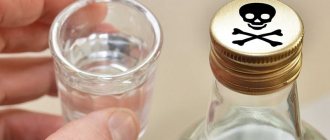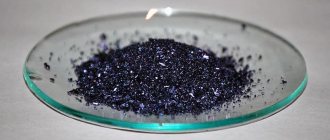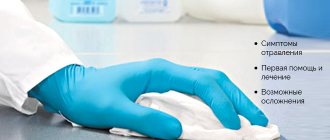Antifreeze and antifreeze are indispensable products for car owners, as their action is aimed at cooling the engine even in the hottest heat. At the same time, the composition of this liquid, which has a predominantly blue, turquoise tint, is a strong poison for the human body. It would seem, who would drink this chemical! But cases of antifreeze poisoning are not decreasing every year. Most often, children and adults are admitted to the hospital after drinking the substance purposefully to commit suicide. It is inappropriate to talk about what prompts people to take such steps; it is better to pay attention to the symptoms of antifreeze poisoning and methods of providing first aid.
The dangers of antifreeze
All chemical components make the liquid pure poison. You can be poisoned simply by antifreeze vapors. By inhaling volatile substances, a person risks destroying brain cells and causing pathogenesis of the genitourinary system, liver, and central nervous system. Long-term inhalation of antifreeze vapors provokes male sexual dysfunction and inhibits the female reproductive system.
People store antifreeze at home without thinking that it is dangerous for children and representatives of the animal world. For example, 5 ml of a substance is enough for a cat to receive a lethal dose.
Children need to be reminded that antifreeze is poison, and the liquid should be stored in a place where children cannot reach.
An adult dies after taking only 100-250 ml, but a couple of tablespoons is enough for a child. If a person survives, it takes months for the urinary system to recover. Consequences: vision dysfunction, irreversible damage to brain cells, etc.
Possible consequences and prognosis
The likelihood of developing complications depends on the nature of the antifreeze drunk. Poisoning with ethylene glycol-based antifreeze:
- death occurring on the first day after consuming a toxic agent;
- if the victim survives, there may be a complete absence of urine for several days until kidney function normalizes;
- various damage to areas of the brain, and vision loss may become irreversible.
The consequences of poisoning with methanol-based antifreeze are determined by extreme toxicity. For the development of destructive complications, a small amount of fluid is needed, so the degree of likely consequences is determined by the physiological characteristics that the individual patient’s body is endowed with and the speed of care.
Toxicity of antifreeze vapors
Antifreeze, getting inside the body, causes irreversible processes, destroying important systems. Intoxication from ingestion is much more destructive than from ingestion of vapors. However, at a certain consistency, coolant vapors cause the same symptoms of antifreeze poisoning.
According to established sanitation standards, the consistency of vapor in the air can be maximum 0.005g/1m3. Certain vehicle malfunctions allow vapors to penetrate into the vehicle interior, exceeding permissible concentrations. A long trip in such a car results in poisoning not only for the driver, but also for the passengers. Maintenance workers can be poisoned by ethylene glycol vapor if safety precautions are not followed.
The most common type of vapor poisoning is its penetration through a car heating unit. Ethylene glycol is a dihydric alcohol. When interacting with water, the substance settles on the dashboard and glass. Thus, antifreeze has a negative effect on humans without direct contact.
Alcohol “therapy”: tested by scientists!
There is an opinion that in case of accidental ingestion of coolant, the best medicine for the victim is alcohol. It is difficult to say how effective such an “antidote” is, but scientists from England have already announced the success of their experiments. All cases of poisoning, which they fought with the help of intoxicating drinks, ended safely, without drastic consequences for the internal organs of the victims. The secret of this treatment is simple - every hour, take a few sips of strong alcohol (vodka, whiskey, cognac).
The duration of the recovery period after antifreeze poisoning depends on the degree of damage to the body. Following basic safety precautions when using the substance and preventing it from falling into children’s hands will help reduce the likelihood of intoxication to zero.
Symptoms of poisoning
Antifreeze poisoning is characterized by symptoms that are detected 1-2 hours after the liquid enters the body. Intoxication becomes mild, moderate or severe. The process depends on the amount drunk. There are two ways of further development: the cerebral phase, the hepatorenal phase.
Brain phase
During the brain phase, the poison has a direct effect on the nervous system. Nervous excitability occurs, and the effect of intoxication is comparable to that of a drug.
Symptoms of the brain phase:
- The skin and mucous membranes turn red, subsequently carbohemoglobin accumulates and the epidermis acquires a bluish tint.
- Arousal of a psycho-emotional nature appears. The process is expressed in talkativeness and bustle. Euphoria gives way to depression, and a sleepy state occurs.
- There is noticeable instability during vertical movement.
- The muscles are weakening.
- Nagging pain appears in the epigastric and lower back areas.
- There is a release of vomit.
- The limbs tremble involuntarily.
- Convulsions occur.
As soon as the intoxication gains strength, the poisoned person is in a coma. The severe phase is accompanied by involuntary release of urine and feces. Initially, the rapid pulse slows down greatly. There is no reaction of dilated pupils to light effects. Inhalations are rare, deep and noisy.
The brain phase lasts no more than 48 hours, then the victim will feel better or die.
Hepatorenal phase
Ethylene glycol intoxication in the hepatorenal phase lasts from 3 to 20 days. The period is distinguished by a long healing period, since toxic substances negatively affect the kidneys. Each symptom must be carefully monitored.
- The volume of urine emitted rapidly decreases until it disappears.
- An irresistible thirst arises.
- There is a persistent increase in blood pressure.
- The victim suffers from diarrhea with severe pain in the abdomen against a background of weakness, apathy, loss of appetite, and headache.
- The liver enlarges, causing pain in the right side.
- Pasternatsky's symptom is monitored.
- Blood pH is disrupted.
The effect of the substance on the human body
100 ml - lethal dose of ethylene glycol
Of course, the most severe cases of poisoning occur due to the ingestion of substances containing ethylene glycol. In fact, ethylene glycol is a poison that destroys blood vessels and cells, causing acidosis (excessive acidity of tissues).
As a result, the action of this poison affects the central nervous system, and the kidneys fail.
After ingesting antifreeze, death is guaranteed to occur if the liquid contained 100 ml of ethylene glycol. Usually 50 ml or less is enough for death.
Symptoms of acute ethylene glycol poisoning appear 2-13 hours after ingestion.
Therefore, by the way, you should not focus on the physical state of a completely satisfied “Kulibin”, who drinks a drink that has been extracted in one way or another from government-issued antifreeze. Complications develop later, and many of these characters die without regaining consciousness.
Ethylene glycol poisoning is often caused by the victims themselves.
2 hours after consumption, the poisoned person may experience convulsions, hallucinations, stupor, stupor (stunning) and coma. Cerebral edema may develop, which is almost always fatal.
Photo gallery: symptoms of acute ethylene glycol poisoning
- 40% of those who were poisoned and did not die on the first day die within a month from kidney failure;
- The rest survive, having escaped with only transient damage to the nervous system and subsequent chronic kidney diseases (glomerulonephritis, pyelonephritis,).
Almost half of those who were poisoned by ethylene glycol and did not die in the first day may die from kidney failure
Oxalate crystals are actively deposited in the kidneys, which can subsequently transform into urolithiasis in survivors.
In addition, during the first 3 days, pulmonary edema, pneumonia and a fulminant form of heart failure may develop due to the vascular component of poisoning.
Heart failure, by the way, may remain even after such patients are cured. In such cases, as a rule, it leads to the death of patients over the next 5 years.
Ethylene glycol vapor poisoning in chemical production
Both ethylene glycol itself and its esters that penetrate the body through the skin are poisonous.
The latter is observed in chemical production conditions.
Workers, as a result of chronic poisoning with ethylene glycol vapors, experience the phenomenon of vegetative-vascular dystonia.
Vitality gradually decreases, muscle weakness and drowsiness appear, up to loss of consciousness.
Photo gallery: symptoms of chronic ethylene glycol vapor poisoning
The activity and number of white blood cells (leukocytes, lymphocytes, neutrophils) decreases. Cellular elements are deformed, red blood cells are less able to transport oxygen, and their shape changes.
Problems with the eyes begin - constant conjunctivitis, dryness. Due to damage to the nervous system, nystagmus appears.
Pharyngitis, laryngitis, and bronchitis become more active. Many workers complain of constant nausea, abdominal pain, and vomiting. Oliguria and anuria may develop (urination disappears, up to the development of hydronephrosis of the kidney).
If you develop these symptoms, contact your doctor directly. Quite often situations arise when management (understanding what’s going on) suggests “just relaxing at home,” while the symptoms of poisoning are not recorded on paper. Because of such “kindness,” you can lose the quite decent compensation and benefits provided by law.
First aid
First aid during antifreeze poisoning must be provided correctly. Actions before the arrival of the medical team determine the further fate of the victim. Failure to take timely measures contributes to the spread of toxins in the human body. Irreversible processes are being generated, related to kidney and liver damage, vascular destruction, and disorders of brain activity. As a result, death may occur.
Measures must be taken in the following order:
- Clear the contents of the stomach with a solution of water and soda. You will need 2 tbsp. for 1 liter of water.
- Give the person a sorbent. Use Smecta, activated carbon, Enterosgel, etc.
- Place the poisoned person in a calm environment.
- Kidney problems develop quickly; you will need to ensure plenty of fluids.
- The medical team is called before the first measures are taken.
Symptoms of intoxication
Toxic substances affect various body systems, causing the following symptoms:
| Respiratory system |
|
| Urinary system |
|
| Circulatory, cardiovascular systems |
|
| Muscular system |
|
| Nervous system |
|
| Skin |
|
| Gastrointestinal tract |
|
After ingesting brake fluid, signs of intoxication may develop rapidly or may not appear for several days. The second option is the most dangerous, because... in this case, severe kidney damage occurs and death occurs suddenly. If you accidentally swallow refrigerant, you should always seek medical attention.
Help with burns
In case of burns from antifreeze, the following steps must be taken. If the skin is corroded by antifreeze liquid, it is necessary to treat the affected area with Chlorhexidine or Furacilin solution. Treating the affected area with Panthenol spray helps.
A burn with antifreeze causes tissue damage to the deep layers. In such a situation, it is recommended to use antimicrobial and wound healing agents. Olazol spray helps. Change the sterile dressing at regular intervals. For mild burns without blisters, agents that help regeneration are used. For example, Solcoseryl gel. To relieve pain, painkillers from the analgesic group are used.
It is forbidden to treat the injured area of skin with vegetable oils or raw eggs. It is strictly forbidden to use alcohol tinctures for disinfection!
Treatment
An ambulance responding to a call for antifreeze poisoning first of all gives the victim an antidote - ethyl alcohol. A five percent solution is administered intravenously through droppers. In addition, calcium chloride is administered to neutralize the effects of the poison.
Further actions of doctors are aimed at maintaining and restoring the systems of the human body. Diuretics are prescribed to remove toxins through urine. The patient is connected to an artificial kidney machine. The procedure restores the body's balance in terms of water and electrolytes. The patient is prescribed treatment: prednisolone and glucose; vitamins B and C; adenosine triphosphoric and folic acid.
Diagnosis of the problem
If, after consuming alcoholic beverages of dubious origin, hallucinations, pain, convulsions, and vomiting appear, it is necessary to urgently take the victim to a doctor.
During the examination, the following signs are observed in a person poisoned with ethylene glycol:
- The retinal veins dilate and the optic discs become pale. The doctor to whom the victim is taken can, based on this sign alone, understand the cause of the poisoning in time;
- There is no consciousness after poisoning, the pupils almost do not react to light;
- The victim breathes rapidly, dry wheezing can be heard;
- Typical tachycardia, heart sounds are muffled.
In parallel with hospitalization, to clarify the diagnosis, an analysis of biochemical blood parameters is performed, the concentration of glucose, alcohol, acetone, creatinine, salicylates and much more is determined. This makes it possible to distinguish poisoning with eylene glycol from poisoning, for example, with methyl alcohol or alcoholic ketoacidosis.
Precautionary measures when working with liquids containing ethylene glycol
To prevent antifreeze poisoning, precautions are taken in advance. Store technical fluids in their original packaging. A special place is allocated where children and animals cannot reach.
Malfunctions in the operation of the car heater must not be allowed to avoid the spread of vapors in the car interior.
When working with brake fluid or antifreeze, safety precautions are observed, a respirator, gloves, aprons, etc. are used.
When purchasing antifreeze, you should carefully read the composition of the liquid. Propylene glycol is an analogue of ethylene glycol, but the chemical composition does not harm the human or animal body or the environment.
Preventive measures
To avoid possible entry of antifreeze into the body and to protect yourself and other people from poisoning, it is recommended:
- tell employees at work or at home about the dangers of this substance;
- exercise strict control at the enterprise over the consumption of antifreeze;
- add neutral components that change the smell and color of the substance;
- organize secure storage of liquid in an inaccessible place.
Antifreeze is a liquid with a low freezing point intended for cooling internal combustion engines of cars. It is a mixture of water and ethylene glycol.











